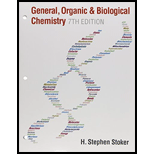
Concept explainers
(a)
Interpretation:
The flavor/odor and uses associated with thymol has to be identified.
Concept Introduction:
Flavoring agents are the substances that are added to food to give flavors. They have their own characteristic odor also. They are obtained from natural source and synthesized artificially also.
(b)
Interpretation:
The flavor/odor and uses associated with eugenol has to be identified.
Concept Introduction:
Flavoring agents are the substances that are added to food to give flavors. They have their own characteristic odor also. They are obtained from natural source and synthesized artificially also.
(c)
Interpretation:
The flavor/odor and uses associated with isoeugenol has to be identified.
Concept Introduction:
Flavoring agents are the substances that are added to food to give flavors. They have their own characteristic odor also. They are obtained from natural source and synthesized artificially also.
(d)
Interpretation:
The flavor/odor and uses associated with vanillin has to be identified.
Concept Introduction:
Flavoring agents are the substances that are added to food to give flavors. They have their own characteristic odor also. They are obtained from natural source and synthesized artificially also.
Want to see the full answer?
Check out a sample textbook solution
Chapter 14 Solutions
Bundle: General, Organic, and Biological Chemistry, 7th + OWLv2 Quick Prep for General Chemistry, 4 terms (24 months) Printed Access Card
- Give one medical application of the α-naphthol.arrow_forwardDoes it safe to use sunscreen E on the acne prone skin, Sunscreen E has lists of ingredients below (descending order)…. aqua homosalate Alcohol Denat. Butyl Methoxydibenzoylmethane Bis-ethylhexyloxyphenol methoxyphenyl triazine Ethylhexyl Salicylate Ethylhexyl Triazone Diethylamino Hydroxybenzoyl Hexyl Benzoate Tapioca Starch C12-15 Alkyl Benzoate Dibutyl Adipate Phenylbenzimidazole Sulfonic Acid Stearyl Alcohol Butylene Glycol Dicaprylate/Dicaprate Copernicia Cerifera Cera Glyceryl Stearate Lauroyl Lysine Triacontanyl PVP Glycyrrhetinic Acid Glycyrrhiza Inflata Root Extract Glycerin Chondrus Crispus Extract Silica Dimethyl Silylate Sodium Stearoyl Glutamate Dimethicone Xanthan Gum Acrylates/C10-30 Alkyl Acrylate Crosspolymer Trisodium EDTA Sodium Hydroxide Sodium Chloride Phenoxyethanol Parfumarrow_forwardAside from being an anti allergy medication , what important role or what other use does antihistamines play in the dental practice specially to those with allergy to both amides and esters anesthesia?arrow_forward
- A. An oil which contains cyclic fatty acids and once used in the treatment of leprosy is (A) Elaidic oil (B) Rapeseed oil (C) Lanoline (D) Chaulmoogric oilarrow_forwardFind the (A) innovator brands of these drugs, (B)leading brands in the Philippine market and the (C) taxonomical source of these drugs Donepezil Edrophonium Demecarium Physostigmine Pyridostigimine Amberonium Parathion Malathion EchoThiophosphate IsoptoFluorophosphatearrow_forwardDoes it safe to use this sunscreen © on acne prone skin, and in peeling skin condition should we use sunscreen or not This sunscreen has lists of ingredients below (descending order)…. WATER CYCLOPENTASILOXANE ZINC OXIDE POLYGLYCERYL-3 POLYDIMETHYLSILOXYETHYL DIMETHICONE TRIETHOXYSILYLETHYL POLYDIMETHYLSILOXYETHYL HEXYL DIMETHICONE TITANIUM DIOXIDE SILICA / METHICONE ETHYLHEXYL METHOXYCINNAMATE PHENOXYETHYL CAPRYLATE BUTYLENE GLYCOL ZINC PCA GLYCERIN POLYGLYCERYL-10 LAURATE COCO-CAPRYLATE/CAPRATE DICTYOPTERIS MEMBRANACEA EXTRACT DICAPRYLYL CARBONATE LAURYL PEG-9 POLYDIMETHYLSILOXYETHYL DIMETHICONE DIETHYLAMINO HYDROXYBENZOYL HEXYL BENZOATE CAPRYLYL METHICONE POLYMETHYLSILSESQUIOXANE BIS-ETHYLHEXYLOXYPHENOL METHOXYPHENYL TRIAZINE Undecane (and) Tridecane PANTHENOL TOCOPHERYL ACETATE LENS ESCULENTA (LENTIL) SEED EXTRACT PEG-8 TOCOPHEROL ASCORBYL PALMITATE ASCORBIC ACID CITRIC ACID BISABOLOL PLANKTON EXTRACT DIMETHICONE CROSSPOLYMER CI 77492 TRIETHOXYCAPRYLYLSILANE STEARIC ACID CI 77491…arrow_forward
- In A Tabular form, Find the (A) innovator brands of these drugs, (B)leading brands in the Philippine market and the (C) taxonomical source of these drugs: Neostigmine Atropine Scopolamine Hyoscyamine Homatropine Ipratropium Tiotropium Clinidium Cyclopentolate Dicyclomine Eucatropine Benztropine Orphenadrinearrow_forward34. A dermatologic lotion contains 1.25 mL of liquefied phenol in 500 mL. Calculate the percentage (v/v) of liquefied phenol in the lotion. 34. 0.25% v/v liquefied phenolarrow_forwardFind the innovator brands of these drugs, leading brands in the Philippine market and the taxonomical source of these drugs: A. Biperiden B. Procyclidine C. Trihexyphenidyl D. Isopropamide E. Tropicamide F. Diphenamil G. Ethopropazine I. Papaverine J. Meclizine (Bonamine) K. Dicycloverine L. Oxybutynin M. Loperamide N. Diphenoxylate O. Morphine P. Pralidoxime Q. Diacymonoximearrow_forward
- Published studies indicate that all of the following essential oils have antitumoral properties except: Choose one answer. a. Brazilian rosewood b. Greek sage c. cypress hiba d. rosearrow_forwardWould puromycin be useful for the treatment of a virus infection? Why or why not? Would chloramphenicol be useful?arrow_forwardTRUE OR FALSE Properties of a drug suitable for transdermal use include: High molecular mass Low lipophilicity Low required daily dose Low potency High partition coefficient Problems with opioid TDDS include: Poor patient compliance Allergy Constipation Respiratory depression Cognitive dysfunctionarrow_forward
 Human Anatomy & Physiology (11th Edition)BiologyISBN:9780134580999Author:Elaine N. Marieb, Katja N. HoehnPublisher:PEARSON
Human Anatomy & Physiology (11th Edition)BiologyISBN:9780134580999Author:Elaine N. Marieb, Katja N. HoehnPublisher:PEARSON Biology 2eBiologyISBN:9781947172517Author:Matthew Douglas, Jung Choi, Mary Ann ClarkPublisher:OpenStax
Biology 2eBiologyISBN:9781947172517Author:Matthew Douglas, Jung Choi, Mary Ann ClarkPublisher:OpenStax Anatomy & PhysiologyBiologyISBN:9781259398629Author:McKinley, Michael P., O'loughlin, Valerie Dean, Bidle, Theresa StouterPublisher:Mcgraw Hill Education,
Anatomy & PhysiologyBiologyISBN:9781259398629Author:McKinley, Michael P., O'loughlin, Valerie Dean, Bidle, Theresa StouterPublisher:Mcgraw Hill Education, Molecular Biology of the Cell (Sixth Edition)BiologyISBN:9780815344322Author:Bruce Alberts, Alexander D. Johnson, Julian Lewis, David Morgan, Martin Raff, Keith Roberts, Peter WalterPublisher:W. W. Norton & Company
Molecular Biology of the Cell (Sixth Edition)BiologyISBN:9780815344322Author:Bruce Alberts, Alexander D. Johnson, Julian Lewis, David Morgan, Martin Raff, Keith Roberts, Peter WalterPublisher:W. W. Norton & Company Laboratory Manual For Human Anatomy & PhysiologyBiologyISBN:9781260159363Author:Martin, Terry R., Prentice-craver, CynthiaPublisher:McGraw-Hill Publishing Co.
Laboratory Manual For Human Anatomy & PhysiologyBiologyISBN:9781260159363Author:Martin, Terry R., Prentice-craver, CynthiaPublisher:McGraw-Hill Publishing Co. Inquiry Into Life (16th Edition)BiologyISBN:9781260231700Author:Sylvia S. Mader, Michael WindelspechtPublisher:McGraw Hill Education
Inquiry Into Life (16th Edition)BiologyISBN:9781260231700Author:Sylvia S. Mader, Michael WindelspechtPublisher:McGraw Hill Education





